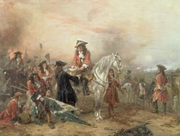
The Duke of Marlborough Signing the Despatch at Blenheim
Robert Alexander Hillingford (January 28, 1828 – 1904) was an English painter. He specialized in historical pictures, often battle scenes.
Biography[]
He was born in London on January 28, 1828, and studied at the Kunstakademie Düsseldorf in 1841 for five years. He is associated with the Düsseldorf school of painting. He then traveled to Munich, Rome, Florence and Naples, where he married and worked for several years, producing paintings of Italian life. One painting from this period entitled The Last Evening of the Carnival was exhibited at St. Petersburg in 1859. He returned to London in 1864,[1] and first exhibited at the Royal Academy in 1866; it was at this time that he began to work on historical subjects, especially of the Napoleonic Wars. He was a regular exhibitor at the Royal Academy, British Institution and at other galleries. While he was attracted to costume pieces such as An incident in the early life of Louis XIV and During the wanderings of Charles Edward Stuart', he also included some contemporary military scenes including his 1901 RA painting South Africa, 1901 - The Dawn of Peace.


Lord Hill invites the last remnants of the French Imperial Guard to surrender
The original paintings often come up at auction, and, with a large amount of the collection dispersed in 1998, the original paintings are widely scattered.
Paintings[]
- The Duchess of Richmond's Ball (1870s – Goodwood House)[2]
- Yet Still a King (1888 – Kelvingrove Art Gallery and Museum)
- Hurry up the Guns: Wellington driving the French our of Spain and into France (Queen's Royal Lancers)
- The Escape of Joseph Bonaparte, King of Spain with British troopers charging (Queen's Royal Lancers)
- Surrender: The capture of General Lefebre Desnouettes at the Ford of the Elsa at Benavente, 1809, by Pte. Luke Guisdall, 10th Hussars (Royal Hussars)
- The Duke of Marlborough saving the day at Ramillies (Queen's Royal Lancers)
- Ramillies, 23 May 1706: capture of the standards and kettledrums by the Queen's Regiment of Horse (Royal Dragoon Guards)
- The Defence of Hougoumont
- After Waterloo: The English Army halting upon what had been the French position... (1889 – Institute of Directors)
- Napoleon's peril at Brienne-le-Chateau (1891)
- The Morning of Waterloo (1896)

Summoned to Waterloo — depicts revellers leaving the Duchess of Richmond's ball as soldiers march out of Brussels to war
- Summoned to Waterloo: Brussels, dawn of June 16, 1815 (1898)
- Battle of Balaclava, Charge of the Light Brigade (1899)
- Sebastopol: the attack on the Redan (1899)
- Death of Sir Richard Granville, captain of the Revenge, on board the Spanish Flagship San Pablo after the Battle of Flores (1899 – Victoria Art Gallery, Bath)
- Charge of the Light Brigade (1899)
- The Scots Greys among the French Guns at Waterloo (1899 – Royal Scots Dragoon Guards)
- A critical moment at Quatre Bras (1900)
- The flight of the French through the town of Vittoria: Peninsular War (1900)
- South Africa, 1901: The Dawn of Peace. (1901)
- George II at Dettingen (1902)
Notes[]
- ↑ Champlin & Perkins 1913, pp. 260,261.
- ↑ Baird 2007, p. 157.
References[]
- Champlin, John Deniso; Perkins, Charles C., eds (1913). "Hillingford, Robert Alexander". Cyclopedia of painters and paintings. 2. New York: C. Scribner's sons. pp. 260,261.
- Baird, Rosemary (2007). Goodwood: Art and Architecture, Sport and Family. Frances lincoln. p. 157. ISBN 0-7112-2769-1.
- Robert Hillingford at military-prints.com
Further reading[]
| Wikimedia Commons has media related to Category:Robert Alexander Hillingford. |
- Harrington, Peter. (1993). British Artists and War: The Face of Battle in Paintings and Prints, 1700-1914. London: Greenhill. ISBN 1-85367-157-6
- Roe, F. Gordon, "The Hillingford Sage", Connoisseur, Vol. 190, No. 763, September 1975, pp. 50–55.
The original article can be found at Robert Alexander Hillingford and the edit history here.